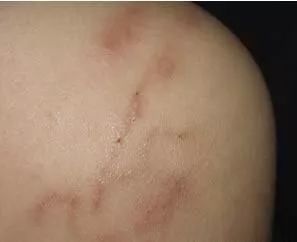
You’re getting dressed after a shower and you notice them: thin, red or purplish lines snaking across your abdomen. Your first, logical thought is stretch marks. After all, they’re common after weight fluctuations, pregnancy, or simply with age. You reach for the cocoa butter, assuming it’s a cosmetic concern.
But what if these lines are different? What if they are raised, tender to the touch, and seem to be spreading in a distinct, almost linear pattern? In this case, these red lines on your abdomen aren’t stretch marks. They are very often a visible map of an internal infection, tracing the path of your lymphatic vessels as your immune system fights a battle beneath the skin.
This condition has a specific and telling name: Lymphangitis.
The Difference Between a Stretch Mark and a Danger Signal
It’s crucial to know how to tell them apart.
- Stretch Marks (Striae): These are caused by the tearing of the dermis, the deep layer of skin, due to rapid stretching. They often start as red or purple lines (striae rubra) but eventually fade to silvery-white scars (striae alba). They are not painful, hot, or swollen. They are a textural change in the skin itself.
- Lymphangitic Lines: These are not scars. They are inflamed lymphatic vessels. Think of them as red, angry highways on a map, showing the route an infection is taking from a wound back toward the core of your body. They are typically:
- Red, hot, and tender.
- Thin and linear, spreading in a distinct line or series of lines.
- Accompanied by other systemic symptoms.
The Body’s Message: Tracing the Infection Highway
Your lymphatic system is your body’s secondary circulation and primary defense network. It carries immune cells and drains waste and pathogens from your tissues. The vessels are normally invisible.
When a bacterial infection—often from a small, forgotten cut, an insect bite, a splinter, or even a small crack in the skin on your foot or hand—enters the body, it can get into these lymphatic vessels. Your immune system responds with intense inflammation in the vessel walls themselves, making them visible as those painful red lines.
The lines are literally tracing the path the infection is taking as it travels from the original site toward your lymph nodes (typically in the groin or armpit), which act as filtering stations. This is why you might also feel a tender, swollen lump in your groin or armpit—it’s a lymph node working overtime.
What Your Body is Urgently Telling You
The appearance of lymphangitic lines is your body’s way of sending a flare. It is signaling that a localized infection has become a systemic threat and is marching toward your bloodstream, a condition that can lead to life-threatening sepsis if left untreated.
This is not a wait-and-see situation.
You must seek immediate medical attention if you see red lines that are:
- Spreading in a distinct linear pattern.
- Warm or hot to the touch.
- Painful or tender.
- Accompanied by a fever, chills, rapid heart rate, or general feeling of being unwell.
What to Expect and How to Respond
When you see a doctor, they will:
- Search for the Source: They will meticulously look for the original point of infection—a small cut, scrape, or infected hair follicle you may have missed.
- Prescribe Antibiotics: This is not optional. Because the infection is spreading, powerful oral or intravenous antibiotics are required to stop it.
- Address the Symptoms: They will recommend rest, elevation of the affected limb, and possibly anti-inflammatory medication.
Those red lines on your abdomen, arm, or leg are more than a skin rash. They are a real-time topographic map of your immune system’s desperate fight. Recognizing the difference between a benign stretch mark and the dangerous signal of lymphangitis is critical. By understanding this message and acting swiftly, you are not just treating a skin condition; you are answering a call to prevent a serious systemic infection, safeguarding your health from the inside out.